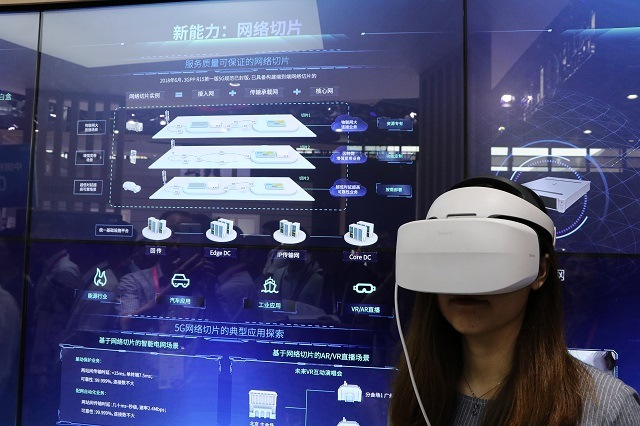China Mobile Works with Huawei to Jointly Demonstrate the First VR Broadcasting Based on 5G Network Slicing
[Shanghai, China, June 28, 2018] At MWC Shanghai 2018, China Mobile worked with Huawei and Let in VR to jointly demonstrate the industry's first VR broadcasting service based on 5G network slicing, creating an immersive live experience for exhibition guests.

Demonstration of VR broadcasting based on 5G network slicing
China Mobile teamed up with Huawei and other manufacturers to carry out research and verification on network slicing and continuously explored new business models with the goal of accelerating commercialization of 5G applications.
As one of the recognized 5G killer applications in the future, VR has become a hot topic in the industry in recent years. The VR broadcasting service incorporates Huawei's 5G core network and base stations, a VR broadcasting solution provided by Let in VR, and Huawei's VR2 terminal. Huawei's 5G core network is a cloud-based core network, which uses a service based architecture (SBA) to modularize network functions. Additionally, Huawei's 5G core network integrates a lightweight slice manager to provide lifecycle management, such as slice design, online purchase, real-time provisioning, and self-service monitoring for services including VR broadcasting. This slice manager helps operators accelerate slice deployment and business closed-loop. The VR broadcasting solution provided by Let in VR uses technologies such as real-time color tuning, rendering optimization, compression encoding, and compatibility with multiple playback terminals to achieve VR 4K broadcasting with ultra-low latency. Huawei VR2 terminal uses the split-type design so that its LCD does not need to be used as display screens. It has the 3K resolution and a 90 Hz refresh rate, supports the fast LCD display technology, making it become the first VR product compliant with the IMAX standards.
VR broadcasting based on 5G network slicing can be widely used in many commercial scenarios, such as concerts, sporting events, and art exhibitions. In these scenarios, a centralized subvenue in a hotspot city is established in addition to the main venue. VR broadcasting uses 5G network slices to create better watching experience for audiences in the subvenue compared with VIP audiences in the main venue. When applied to featured tours, VR broadcasting creates an immersive experience for visitors to places of interest, or when watching folk art performances. When applied to distance education, VR broadcasting provides a virtual educational environment, such as classrooms, laboratories, and outdoor scenes, so that students are fully immersed in learning.
China Mobile and Huawei have accumulated significant technical expertise in 5G research. Their joint demonstration of 5G network slicing and industry-leading release of a service-guaranteed 5G network slicing white paper accelerate the development, business implementation, and ecosystem of 5G industry. This demonstration is a staged achievement in the joint innovation of 5G network slicing. The service solution is also won the second prize in the "Blooming Cup" 5G Application Collection Competition.
MWC Shanghai 2018 runs from June 27 to 29 in Shanghai, China. Huawei is showcasing its products and solutions at booth N3.B40 in the Shanghai New International Expo Centre (SNIEC), and booth N5.ICA01 Innovation City. For more information, please visit http://carrier.huawei.com/en/events/mwcs2018.

